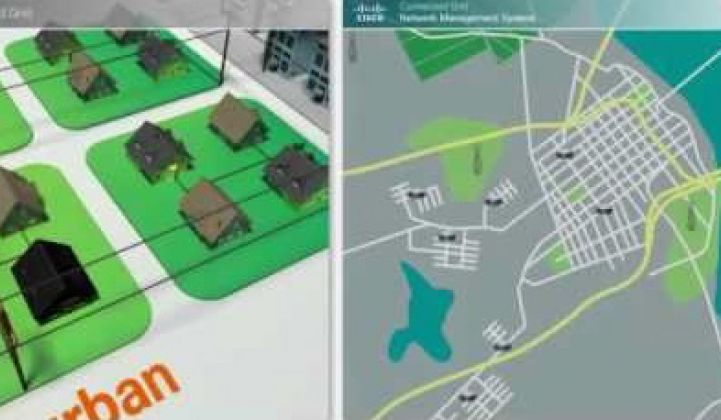Cisco’s bid for smart grid networking kingpin status will be built as much on its partner and developer networking skills as on its grid routers and switches. After all, a network is only as good as the disparate technologies and platforms it tied together.
That’s the backdrop to Monday’s launch of the official “Connected Grid Cisco Developer Network,” which cements some deep ties between Cisco and a roster of smart grid partners like OSIsoft, Proximetry, Space-Time Insight, Alvarion, Itron, Elster, Alstom and Cooper Power Systems, to name a few.
Essentially, Cisco has extended its existing developer support organization, which has about 700 companies and 1,000 product solutions in its catalog, to its smart grid partners. That includes such heavyweights as Itron and Elster, which are integrating Cisco’s IPv6-capable wireless networking into their smart meters, and Alstom and Cooper (now part of Eaton), which are networking their substation and grid gear over Cisco’s technology.
But Cisco’s CDN also brings in a host of back-end IT players, many already Cisco developer partners via other industries. Names on that list include BitStew and Infoblox, which assist in Cisco’s smart grid network management platform, and Symmetricom and Meinberg, which make high-speed switch technology used by Cisco.
At the same time, Cisco software partners are working more closely to package their platforms on the networking giant’s gear in ways that help utilities get new technology up and running, said Sanket Amberkar, senior manager of energy and smart grid marketing. For instance, partnerships with the likes of EMC and VMware or NetApp on IT platforms for data center and network management can also serve as the building blocks for a utility smart grid deployment.
Cisco’s work with OSIsoft helps illustrate how it’s applying this IT management expertise on the smart grid front. OSIsoft, a San Leandro, Calif.-based smart grid and industrial controls data management software vendor, has actually been working with Cisco on telecommunications for years now, and had integrated components of its Pi system on Cisco’s Compute Platform, said Stewart Young, OSIsoft’s alliance manager.
That, in turn, allows both parties to know beforehand just how well their technologies run together under test conditions, as well as real-world deployments. “We’re both infrastructures,” is how Young put it. “Cisco offers the potential to consolidate and reduce the number of, say, isolated and dedicated networks, and push more data through one investment in a sort of multi-functional network … and OSIsoft offers that same concept, pulling data from heterogeneous systems and over IP networks” back to its heavy-duty data management platforms.
As with Cisco’s broader developer partnerships, its smart grid program comes with grades of support, said Malay Thacker, the new program’s manager. Those include interoperability and verification testing, which yields “Cisco Compatible” gear from successful partners. On the smart grid front, partner DNV KEMA helps out on the testing, as does LogRhythm, a company that specializes in helping companies comply with federal NERC-CIP rules on “critical infrastructure” communications and controls projects, including cybersecurity, Thacker said.
On the integration front, Cisco and partner products can share data through an application programming interface (API) and software developer kits (SDK), allowing solutions to be built on top of the Cisco network. Eventually, the Cisco grid partnership can lead to Cisco licensing its technology to be embedded in gear from its partners, as Cisco has done with Itron, Elster and Alstom.
The complete list of Cisco’s new smart grid partners includes: Alstom Grid, Alvarion, BitStew, Cooper Power Systems, DNV KEMA, Elster, InfoBlox, Itron, LogRhythm, M2M Telemetria, Meinberg, OSIsoft, Proximetry, QinetiQ, Space-Time Insight, Subnet Solutions, and Symmetricom.
Cisco is far from the only smart grid contender to be beefing up its partnerships, of course. Smart grid IT giants like Infosys, IBM, Microsoft, Oracle and SAP have built utility alliances and partnerships to bring integrated products to market -- as well as to provide their name to convince utilities to try out new technology.
At the same time, startups like Silver Spring Networks are deepening their relationships with partners up and down the technology chain in hopes of building their existing smart meter networks into multi-purpose smart grid platforms -- just like Cisco wants to. Think of it as a three-legged race for smart grid market share, in which each partner’s leg is tied to another’s. Reaching the finish line is a team effort, and nobody's going to get there alone.



